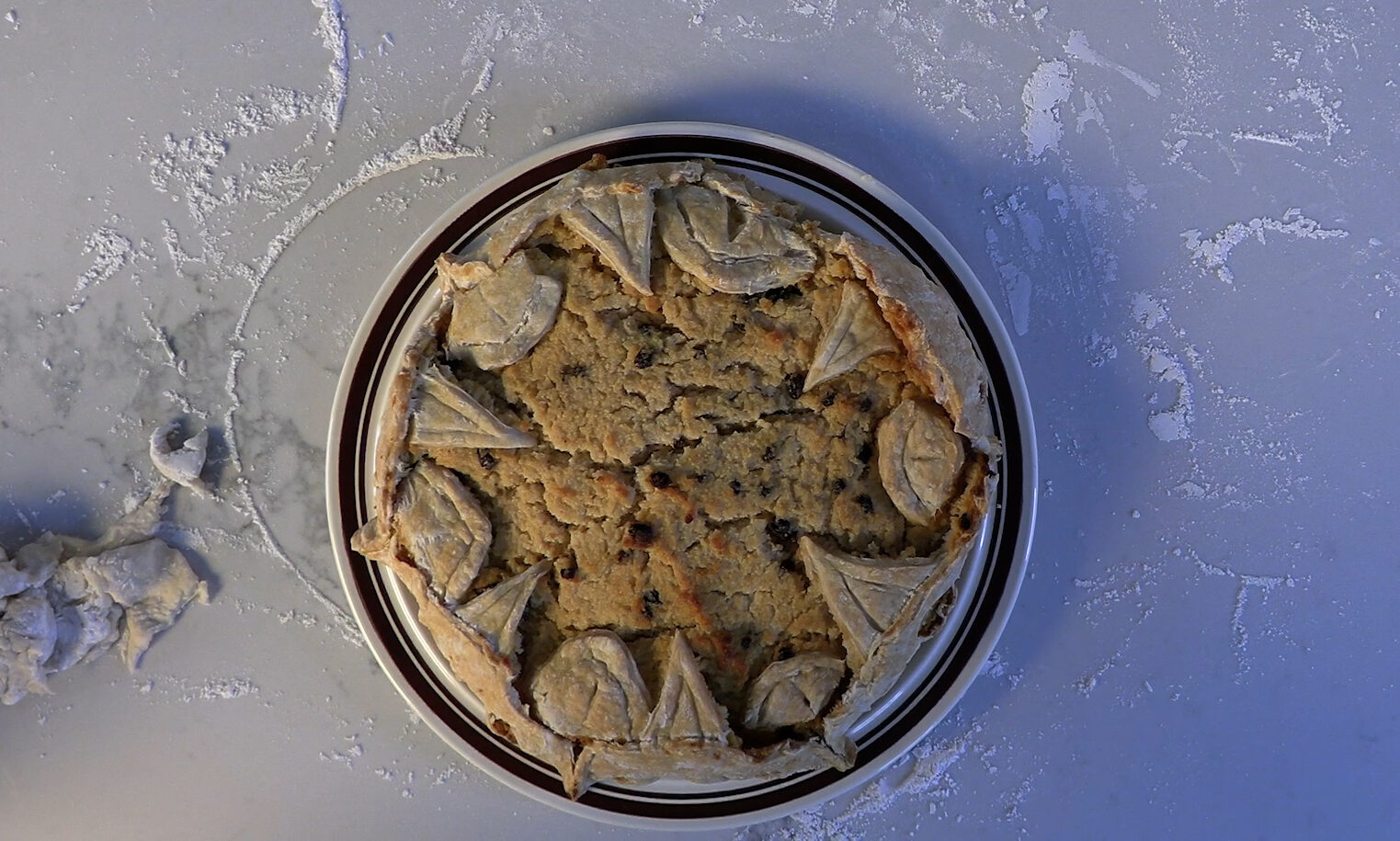
Cooking Like a Pilgrim
Cooking Like a Pilgrim
Do you want to learn how to cook like a Pilgrim?
Then try out one (or all) of these recipes, which have been adapted from books from the 17th-century and modernized for today’s kitchen by: Alexandra Cervenak.
Each recipe below has an accompanying video from The Mayflower Society’s series “Cooking Like a Pilgrim.”
Seventeenth Century Cheesecake
This is a modern adaptation of Robert May’s “To Make Cheesecakes Otherwayes” recipe from his book “The Accomplisht Cook”, published in 1660.
“Take a good morning milk cheese, or better, of some eight pound weight, stamp it in a mortar, and beat a pound of butter amongst it, and a pound of sugar, then mix with it beaten mace, two pound of currans well picked and washed, a penny manchet grated, or a pound of almonds blanched and beaten fine with rose-water, and some salt; then boil some cream, and thicken it with six or eight yolks of eggs, mixed with the other things, work them well together, and fill the cheesecakes, make the curd not too soft, and make the past of cold butter and water according to these forms.”
To make cool Butter Paste for Patty pans or Pasties:
“Take to every peck of flour five pound of butter, the whites of six eggs, and work it well together with cold spring water; you must bestow a great deal of pains, and but little water, or you put out the millers eyes. This paste is good only for pattypan and pasty. Sometimes for this paste put in but eight yolks of eggs, and but two whites, and six pound of butter.”
- Robert May, The Accomplish’t Cook
Makes 1 12 inch cheesecake
Ingredients:
For the paste (crust):
- 2 cups all purpose flour, plus more for rolling dough
- 3 large egg whites
- ½ cup ice water
- 8 tablespoons cold unsalted butter
For the filling:
- 2 lbs. Whole fat ricotta
- 1 cup heavy cream
- 3 large egg yolks
- 4 tablespoons unsalted butter, softened
- ½ cup granulated sugar
- ½ tablespoon ground mace
- ⅓ cup dried currants
- ½ teaspoon rosewater
- 1 pinch salt
- ⅔ cup plain golden bread crumbs
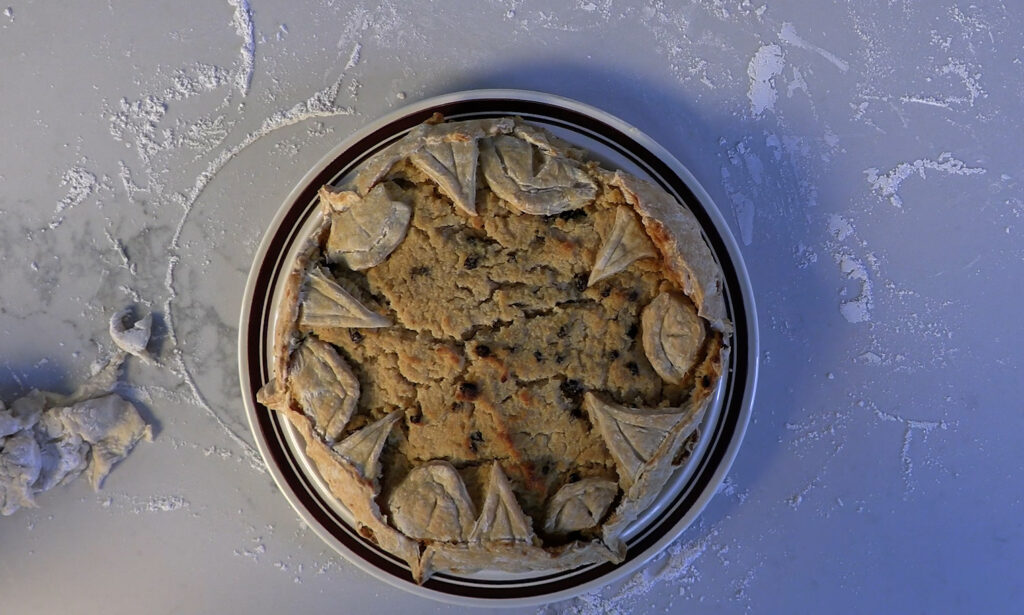
Directions:
To make the paste:
- Separate the whites from three eggs. Set the yolks aside to use for filling.
- Cut the cold butter into small pieces, and add to 2 cups flour in large bowl
- Using your hands or a pastry cutter, and working quickly, rub together the cold butter and flour.
- Crumble the butter until it is in pea-size pieces, and the mixture has a sandy appearance.
- Add the egg whites and ice water to the flour mixture. Again working quickly so as not to warm the butter, form the mixture into a dough. Be careful not to overwork the paste, and stop as soon as it comes together.
- Fashion the paste into a roughly 5 inch disc, and cover in plastic wrap.
- Refrigerate for at least an hour.
To make the filling:
- Begin by making a simple custard. Gently warm the heavy cream over medium heat until the edges start to bubble.
- Temper the egg yolks by adding three tablespoons of the warm cream, and then beat together.
- Slowly stream the tempered yolks into the cream while whisking constantly, until custard is thickened and a pale golden color.
- Remove from heat and set aside.
- In a mixing bowl, add the softened butter to the ricotta. -Using the back of a wooden spoon or a spatula, cream them together until combined. To this mixture add sugar, mace, currants, rosewater and salt. Combine.
- Pour the custard into the ricotta mixture, and gently stir together.
- Add bread crumbs and mix together. The filling should be somewhat stiff, so if the mixture is still too liquidy add more bread crumbs by the tablespoon until desired consistency is reached.
To bake:
- Generously flour the work surface and turn chilled paste onto it.
- Flour top of paste and rolling pin if necessary.
- Roll paste into a roughly 12-13 inch circle, turning the paste as you go, so it doesn’t stick to the work surface.
- To make Robert May’s decorative design, cut a scalloped edge around the paste.
- Transfer paste to a baking sheet lined with parchment paper or silpat (such as by rolling the paste up onto your rolling pin, and then rolling it back out onto the baking sheet).
- Mound the filling into the middle of the paste circle. Don’t panic, it will look quite tall!
- Fold the scallops towards the middle of cheesecake, sealing the edges between each one with your fingers.
- Return cheesecake to the refrigerator to chill for at least 20 minutes.
- Preheat oven to 350 degrees. Bake cheesecake on middle rack for about 1 hour, until paste is light golden brown and the filling has set (the center should still have a slight wobble).
- Cool completely.
- To serve in true 17th century style, cut cheesecake into squares, not wedges!
Cucumber Salad
A modern adaptation of John Parkinson’s “The Use of Cowcumbers” recipe for cucumber salad (1629).
Makes 3-4 servings.
Ingredients:
- 3-4 pickling cucumbers
- 1 1/2 teaspoons salt
- 1/4 cup olive oil
- 1 1/4 tablespoon white wine vinegar
- optional: 1 tablespoon fresh herb chopped (such as dill, mint or parsley)
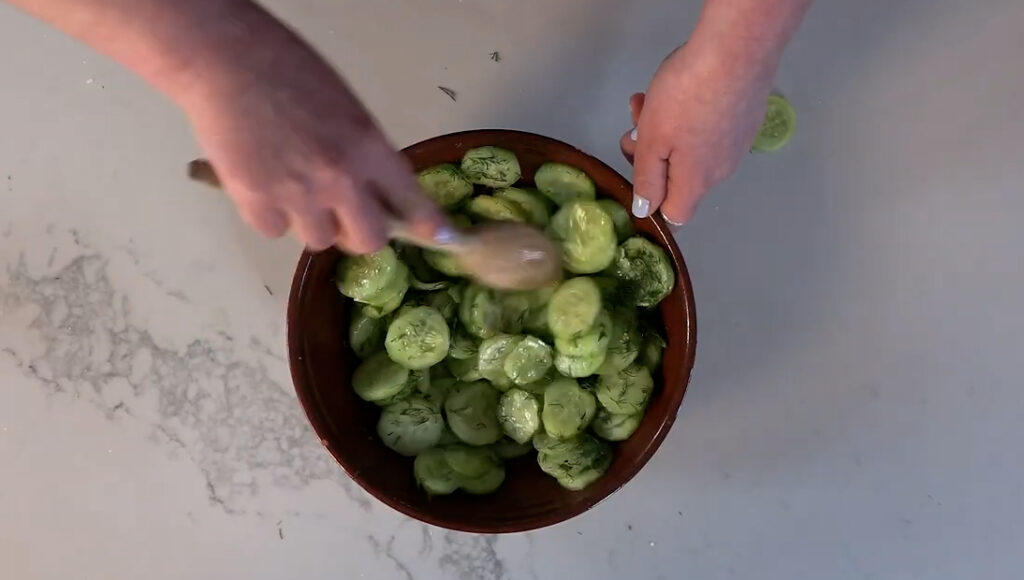
Directions:
- Peel and thinly slice cucumbers. Add to bowl with salt and mix together.
- Let cucumbers and salt sit for at least half an hour, and then pour off excess liquid.
- Meanwhile, mix oil and vinegar (and herb if using). Pour over cucumbers and toss together.
Dijon Mustard
This is a modern adaptation of Robert May’s “Mustard of Dijon or French Mustard” recipe from his book “The Accomplisht Cook”, published in 1660.
“The seed being cleansed, stamp it in a mortar, with vinegar and honey, then take eight ounces of seed, two ounces of cinamon, two of honey, and vinegar as much as will serve, good mustard not too thick, and keep it close covered in little oyster-barrels.” – Robert May, The Accomplish’t Cook
Makes Approximately 1/2 Cup
Ingredients:
- 3 tablespoons of brown mustard seeds
- 2 tablespoons of yellow mustard seeds
- 1/4 teaspoon of cinnamon
- 1/2 cup of apple cider vinegar
- 1/4 teaspoon of salt
- 1/4 cup of honey
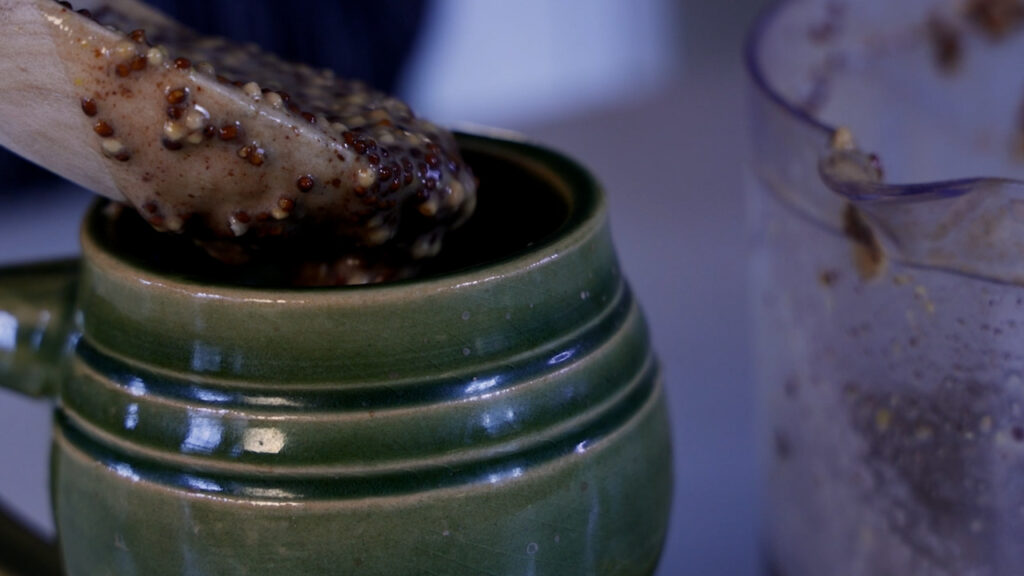
Directions:
- In a blender or food processor, blend the brown mustard seeds, yellow mustard seeds and cinnamon together.
- Add the apple cider vinegar, salt and honey to the mix and blend until mustard seeds begin to break apart and mixture thickens slightly. If you want a smoother mustard, blend until seeds have broken apart completely.
- eal the mustard in an airtight nonreactive container. Keep mustard in the refrigerator at least overnight, but ideally 2-3 days before use. This will allow the flavors to meld, and the seeds to absorb liquid and plumpen (if your mustard seems loose when first blended, don’t worry, this is when it will thicken). Store in the refrigerator.
Note: The Pilgrims obviously did not have access to the electronic cooking tools we use today, so everything was crushed and blended by hand.
Fricassee
Fricassee is a sort of hybrid cooking method that usually starts by boiling or poaching a meat, then finishing it off in a gravy-like sauce. While today we might thicken a sauce with flour, 17th century fricassees were often thickened by the addition of egg yolks. This version of a fricassee is based on recipes from a Dutch cookbook, De Verstandige Kock (The Sensible Cook), originally published in 1667.
The original recipe calls for the use of Verjus, which is a sour juice pressed from unripe grapes, but you can easily swap it for vinegar, lemon juice or white wine. As fricassees appear in both English and Dutch cookbooks of the time, it’s easy to imagine it as a cooking method familiar to the Pilgrims.
Recipes from The Sensible Cook, 1667:
“To prepare young live [meaning, freshly killed] pigeons in an hour and a half. Take Pigeons which have had their necks cut off, place them in a bucket of cold Rain water, after they have been in it for a large half hour scald their feathers with hot water. After they have been cleaned cut them in pieces and then they are boiled in a deep pan with water for an hour and a half. When the water is drained off fry them in Butter, pour on a sauce [made] from Butter, cut parsley, egg yolks with Verjuice, Mace, and Nutmegs, Probatum est. [It has been approved.] Hens, Capons, Turkeys, Rabbits and Pheasants as well as others that are young can be prepared in the same manner.”
“To make a Pullet Fricassee. Take a young Hen, strip off the skin, wash it clean, and chop it into pieces the size of about half a finger, place it in a flat [shallow, earthen-ware] pot and amply cover with water, well skimmed, and then add some Salt and a little whole Pepper and thus let it boil until it is done. Drain off most of the broth, add Butter and minced Parsley and some crushed Mace or Nutmeg and let it fricassee stirring frequently. Then take Lemon juice and 4,5, or 6 Egg yolks beaten and some of the same broth that was drained off, stir it together, pour [the mixture] in the pot with the Hen on the fire, stir steadily so that it stews together and then immediately place it from the pot in a dish and chopped Parsley sprinkled on the rim [of the dish]. “
Makes 3-4 servings.
Ingredients:
- Approximately 1 lb. of cooked turkey or chicken
- 2 tbsp. butter
- ¼ cup chopped parsley, plus more for garnish
- 4 egg yolks, separated
- 4 tbsp of Verjus (Sub: white wine, lemon juice, white wine vinegar)
- ¼ tsp. Mace
- ⅛ tsp. Nutmeg
- ¼ tsp. Salt
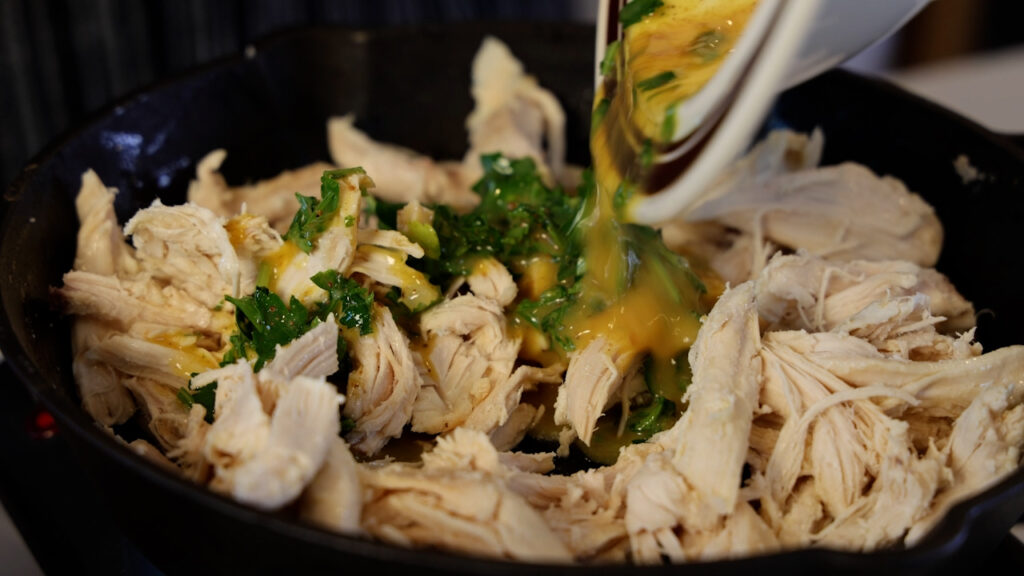
Directions:
- If chicken or turkey is still whole, remove meat from bones and discard skin. Shred meat into manageable pieces. Set aside.
To make sauce:
- Begin by cracking eggs and separating out the yolks into a bowl. Whisk the yolks until smooth.
- Add the mace, nutmeg and salt to the bowl with the egg yolks.
- Next add to the bowl the verjus (or your substitute of choice). Whisk again to combine.
- Coarsely chop parsley and add ¼ cup of it to the bowl with egg yolks. (Reserve some chopped parsley for garnish.)
- Heat a shallow frying pan on low heat, and melt butter. Add the cooked chicken or turkey and allow to warm through.
- Pour sauce over meat and cook on low heat until the sauce has thickened.
- Stir constantly to keep the sauce from burning.
- Cook for several minutes, until the sauce is thick enough to coat the meat.
Warning: Make sure your heat is on low! If your pan is too hot the eggs will scramble instead of thickening your sauce. Depending on your stovetop and the type of pan you are using, you can even remove the pan from heat before pouring on the sauce. You can then allow the residual heat to cook the yolks through.
Transfer the meat to a serving platter and garnish with reserved chopped parsley around the rim and serve.
Stewed Pompion (Squash)
There are very few actual recipes that survive from early New England, but this account of stewed pompion (squash) is one of them. Only crab apples are native to the Americas, so the splash of vinegar in this recipe which gives the squash tartness would have been a welcome taste of home for early colonists.
The Ancient New England Standing Dish
“But the Housewives manner is to slice them when ripe, and cut them into dice, and so fill a pot with them of two or three Gallons, and stew them upon a gentle fire a whole day, and as they sink, they fill again with fresh Pompions, not putting any liquor to them; and when it is stew’d enough, it will look like bak’d Apples; this they Dish, putting Butter to it, and a little Vinegar, (with some Spice, as Ginger, &c.) which makes it tart like an Apple, and so serve it up to be eaten with Fish or Flesh: It provokes Urin extreamly and is very windy.”
- John Josselyn, New-Englands Rarities Discovered
Makes 3-4 servings.
Ingredients:
- 3 pounds of any fleshy squash, such as acorn, butternut or hubbard cut into chunks
- 1 ½ cup water, more if necessary
- 2 tablespoons unsalted butter
- ¼ cup apple cider vinegar
- ⅛ teaspoon ground cloves
- 1 teaspoon ground ginger
- ½ teaspoon ground cinnamon
- ¼ teaspoon salt
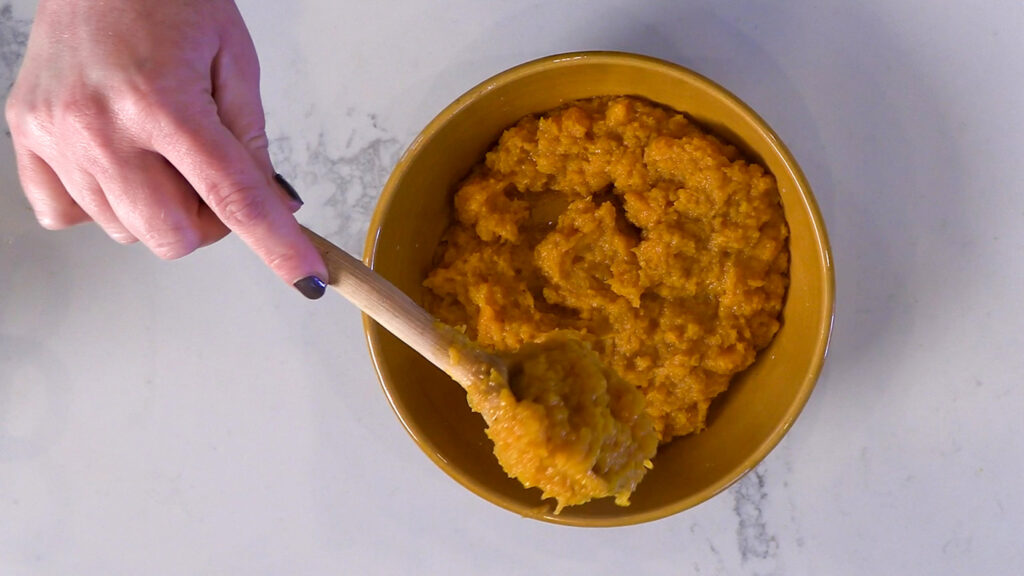
Directions:
- Add the chunks of squash and water into a medium pot. Bring to boil and then turn down to low and simmer covered.
- Stir occasionally, and as pieces soften use your spoon to help break squash apart. If squash seems like it is sticking to the bottom of pot or in danger or burning, add more water as needed. Continue to simmer covered on low heat until squash is entirely softened and broken down, and water is evaporated, about 45 minutes.
- Add spices, salt, vinegar and butter and stir to combine. Cook uncovered until butter is melted, about another 3-5 minutes. Serve warm.
